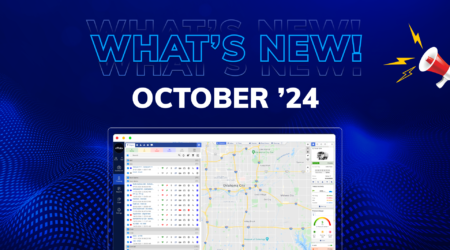Fleet Management in Brazil: Integrating Advanced Telematics for Cost Reduction
Fleet management is an essential aspect of any logistics or transportation business, and it is becoming increasingly important in Brazil. The rise of advanced telematics solutions has revolutionized how companies manage their fleets, offering significant opportunities for cost reduction and efficiency improvements. In this blog, we will explore the landscape of fleet management in Brazil, the benefits of integrating advanced telematics, and how these technologies can lead to substantial cost savings.
 Understanding Fleet Management in Brazil
Understanding Fleet Management in Brazil
Fleet management involves overseeing a company’s vehicle operations to ensure its efficiency, compliance, and cost-effectiveness. In Brazil, fleet management is critical due to the country’s vast geography, diverse road conditions, and the high volume of freight transportation. Managing fleets in such a complex environment requires robust solutions that can handle various challenges.
The Challenges of Fleet Management in Brazil
Brazil’s transportation sector faces several challenges that make effective fleet management crucial:
- Vast Geographic Area: Brazil is the largest country in South America, with diverse landscapes and extensive distances between key cities and industrial hubs. This geographic complexity demands efficient route planning and vehicle utilization.
- Diverse Road Conditions: The road network in Brazil varies significantly, with some areas having well-maintained highways while others suffer from poor infrastructure. Fleet managers must navigate these conditions to ensure timely deliveries and vehicle safety.
- High Fuel Costs: Fuel is one of the most significant expenses for fleet operators. Fluctuating fuel prices and taxes can substantially impact the overall cost of operations, making fuel efficiency a top priority.
- Regulatory Compliance: Brazilian transportation regulations are stringent and constantly evolving. Fleet managers must stay updated with these regulations to avoid penalties and ensure compliance.
- Security Concerns: Cargo theft and vehicle hijacking are prevalent issues in certain regions of Brazil. Ensuring the safety of both drivers and cargo is a critical aspect of fleet management.
The Role of Advanced Telematics in Fleet Management
Telematics technology has emerged as a game-changer in the field of fleet management. By integrating telematics systems, fleet operators can gain real-time insights into their vehicles, drivers, and overall operations. Let’s delve into the benefits of advanced telematics for fleet management in Brazil.
Real-Time Vehicle Tracking
One of the primary advantages of telematics is real-time vehicle tracking. With GPS-enabled devices installed in vehicles, fleet managers can monitor the exact location of each vehicle at any given time. This visibility enables:
- Improved Route Planning: By knowing the precise location of vehicles, fleet managers can optimize routes, reduce travel time, and minimize fuel consumption.
- Enhanced Security: Real-time tracking helps in quickly identifying and responding to any unusual activities or deviations from planned routes, reducing the risk of cargo theft.
- Better Customer Service: Accurate tracking allows fleet managers to provide customers with real-time updates on delivery statuses, improving transparency and satisfaction.
Fuel Management
Fuel costs are a vital part of fleet expenses. Advanced telematics systems offer comprehensive fuel management solutions that can lead to substantial cost savings:
- Fuel Consumption Monitoring: Telematics devices can track fuel usage in real-time, helping fleet managers identify inefficiencies and address them promptly.
- Driver Behavior Analysis: By monitoring driving habits such as idling, speeding, and harsh braking, fleet managers can implement training programs to promote fuel-efficient driving behaviors.
- Route Optimization: Telematics solutions enable better route planning, reducing unnecessary mileage and, consequently, fuel consumption.
Maintenance and Diagnostics
Proper vehicle maintenance is crucial for minimizing downtime and extending the lifespan of fleet vehicles. Telematics systems provide valuable data for maintenance and diagnostics:
- Predictive Maintenance: By analyzing data from various vehicle sensors, telematics systems can predict potential issues before they lead to breakdowns. This proactive approach reduces unexpected downtime and repair costs.
- Maintenance Scheduling: Telematics solutions can automate maintenance schedules based on mileage, engine hours, and other parameters, ensuring that vehicles are serviced at optimal intervals.
- Remote Diagnostics: Telematics devices can send diagnostic trouble codes (DTCs) to fleet managers in real-time, allowing for quick identification and resolution of issues.
Driver Safety and Behavior
Driver behavior has a direct impact on both operational costs and safety. Telematics systems offer tools to monitor and improve driver performance:
- Driver Monitoring: Fleet managers can track driving behaviors such as speeding, harsh braking, and rapid acceleration. Identifying risky behaviors enables targeted training and coaching.
- Safety Alerts: Telematics solutions can send real-time alerts to drivers and managers in case of unsafe driving practices, promoting a culture of safety within the fleet.
- Driver Scorecards: By evaluating driver performance through scorecards, fleet managers can incentivize safe driving and recognize top-performing drivers.
Regulatory Compliance
Navigating the complex regulatory landscape in Brazil requires precise record-keeping and compliance management. Telematics systems assist in this area by:
- Electronic Logging Devices (ELDs): Telematics systems can automatically record driving hours and ensure compliance with regulations related to hours of service (HOS).
- Reporting and Documentation: Automated reporting features simplify the documentation process, making it easier to demonstrate compliance during audits and inspections.
- Geofencing: Telematics solutions can create virtual boundaries (geofences) to monitor and control vehicle movements in restricted or sensitive areas.
Case Studies: Successful Implementation of Telematics in Brazil
To illustrate the real-world benefits of integrating advanced telematics in fleet management, let’s look at some case studies of companies that have successfully implemented these technologies in Brazil.
Case Study 1: Logistics Company
Challenge: A Logistics Company faced challenges in route optimization and fuel management. The company operated a large fleet of delivery trucks across Brazil, and high fuel costs were eating into their profits.
Solution: By integrating advanced telematics, the company gained real-time visibility into their fleet operations. The telematics system provided insights into fuel consumption, driver behavior, and route efficiency.
Results:
- Fuel Savings: The company reduced fuel consumption by 15% through optimized routes and improved driver behaviors.
- Enhanced Efficiency: Real-time tracking allowed for better route planning, resulting in faster deliveries and increased customer satisfaction.
- Reduced Maintenance Costs: Predictive maintenance features minimized unexpected breakdowns and reduced maintenance expenses by 20%.
Case Study 2: Transport Company
Challenge: A Transport Company faced frequent vehicle breakdowns and high maintenance costs. The company needed a solution to proactively manage vehicle health and reduce downtime.
Solution: Telematics system provided the company with predictive maintenance capabilities and real-time diagnostics. This enabled the fleet managers to address potential issues before they escalated into major problems.
Results:
- Decreased Downtime: Predictive maintenance reduced unexpected breakdowns by 30%, keeping more vehicles on the road.
- Cost Reduction: The company saw a 25% decrease in maintenance costs due to timely servicing and repairs.
- Improved Vehicle Lifespan: Regular maintenance extended the lifespan of fleet vehicles, providing long-term savings.
The Future of Fleet Management in Brazil
The integration of advanced telematics in fleet management is not just a trend but a necessity for businesses aiming to stay competitive and efficient. As technology continues to evolve, the future of fleet management in Brazil looks promising, with several emerging trends set to shape the industry.
Electric Vehicles (EVs)
With the global push towards sustainability, electric vehicles are gaining traction in fleet management. Telematics will play a crucial role in managing EV fleets by providing insights into battery health, charging infrastructure, and energy consumption. As Brazil invests in EV infrastructure, fleet managers will need telematics to optimize the use of electric vehicles.
Autonomous Vehicles
The advent of autonomous vehicles presents exciting possibilities for fleet management. Telematics will be integral in monitoring and controlling autonomous fleets, ensuring safety and efficiency. While fully autonomous fleets may still be a few years away, telematics will pave the way for gradual integration.
Big Data and Analytics
The future of fleet management will heavily rely on big data and analytics. Telematics systems generate vast amounts of data, which can be analyzed to uncover trends, optimize operations, and make informed decisions. In addition to that, advanced analytics will enable predictive maintenance, route optimization, and improved driver performance.
Internet of Things (IoT)
The Internet of Things (IoT) will further enhance telematics capabilities. IoT devices embedded in vehicles and infrastructure will provide real-time data on traffic conditions, weather, and road quality. Fleet managers can leverage this data to make dynamic decisions and improve overall efficiency.
Implementing Telematics: Best Practices
For fleet managers looking to integrate advanced telematics into their operations, following best practices can ensure a smooth and successful implementation.
Choose the Right Telematics Solution
Selecting the right telematics solution is crucial. Additionally, consider factors such as the size of your fleet, specific needs, and the scalability of the solution. A range of telematics solutions tailored to different fleet management requirements.
Involve Stakeholders
Successful implementation requires buy-in from all stakeholders, including drivers, managers, and executives. Also, communicate the benefits of telematics clearly and involve them in the decision-making process to ensure smooth adoption.
Train Your Team
Training is essential to maximize the benefits of telematics. Also, ensure that your team understands how to use the telematics system, interpret data, and implement changes based on insights. Continuous training will help in adapting to new features and updates.
Monitor and Evaluate
Regularly monitor the performance of your telematics system and evaluate its impact on fleet operations. Use the data to identify areas for improvement and make necessary adjustments to achieve optimal results.
Focus on Data Security
Data security is a critical aspect of telematics implementation. Ensure that the telematics solution you choose adheres to industry standards for data encryption and protection. Implement robust security measures to safeguard sensitive information.
Conclusion
Fleet management in Brazil is evolving rapidly, driven by the integration of advanced telematics solutions. These technologies offer significant opportunities for cost reduction, improved efficiency, and enhanced safety. By leveraging real-time vehicle tracking, fuel management, predictive maintenance, and driver behavior analysis, fleet managers can optimize their operations and stay competitive in a challenging environment.
As we look to the future, emerging trends such as electric vehicles, autonomous vehicles, big data analytics, as well as the Internet of Things will further revolutionize fleet management. Companies that embrace these advancements will be well-positioned to achieve sustainable growth and operational excellence.
By integrating advanced telematics into your fleet management strategy, you can unlock new levels of efficiency, cost savings, and safety. Start your journey towards a smarter and more connected fleet today.


 Understanding Fleet Management in Brazil
Understanding Fleet Management in Brazil

